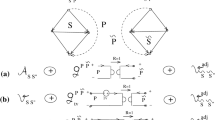Abstract
Multiport transformers offer enhanced matching capabilities for multiport loads. These transformers are analyzed to characterize wideband matching designs. An eigenvalue decomposition of the multiport load produces a geometric description of the sublevel sets of the matching transformers and identifies those frequency bands where multiport transformers are effective. A multiport antenna provides a concrete design example.















Similar content being viewed by others
Notes
Two books on the scattering formalism are Baher [3] and Balabanian and Bickart [4]. Baher omits the factor of 1/2 but carries this rescaling into the power definitions. Most other books use the power-wave normalization [9]: \(\mathbf {a}=R_{0}^{-1/2} \{ \mathbf {v}+ Z_{0} \mathbf {i}\}/2\), where the normalizing matrix Z 0=R 0+jX 0 is diagonal.
Although the lossless 2-ports are a subset of the passive 2-ports, Ball and Helton show that greater gain cannot be achieved by matching over the larger class of passive 2-ports [5]. Consequently, matching can be restricted to the lossless 2-ports.
References
O. Alekseyev, Realizations of an orthogonal multiport transformer by means of hybrids. IEEE Trans. Circuit Theory 19(5), 526–528 (1972)
J.C. Allen, J. Rockway, D. Arceo, Wideband multiport matching; Phase I: Single-feed multiport antennas. SPAWAR Technical Report 1972 (2008). http://www.spawar.navy.mil/sti/publications/pubs/tr/1972/tr1972cond.pdf
H. Baher, Synthesis of Electrical Networks (John Wiley & Sons, New York, 1984)
N. Balabanian, T.A. Bickart, Linear Network Theory (Matrix Publishers, Beaverton, 1981)
J.A. Ball, J.W. Helton, Lie groups over the field of rational functions, signed spectral factorizations, signed interpolations, and amplifier design. J. Oper. Theory 8, 19–65 (1982)
G.C. Calafiore, F. Dabbene, Optimization under uncertainty with applications to design of truss structures. Struct. Multidiscip. Optim. 35(3), 189–200 (2008)
W.-K. Chen, The Circuits and Filters Handbook (CRC Press, Boca Raton, 1995)
G. Czawka, Synthesis of broadband microstrip uncouplers for multiport complex loads, in 14th International Conference on Microwaves, Radar and Wireless Communications, MIKON-2002, vol. 1 (2002), pp. 55–58
J.A. Dobrowolski, W. Ostrowski, Computer-Aided Analysis, Modeling, and Design of Microwave Networks (Artech House, Boston, 1996)
J. Fiennes, C.R. de Souza, The complex transformer as a network-model element. Int. J. Electr. Eng. Educ., 40(1), 27–35 (2003)
H. Gan, On-chip transformer modeling, characterization, and applications in power and low-noise amplifiers. Ph.D. Department of Electrical Engineering, Stanford University (2006)
W.P. Geren, C.R. Curry, J. Andersen, A practical technique for designing multiport coupling networks. IEEE Trans. Microw. Theory Tech. 44(3), 364–371 (1996)
G. Gonzalez, Microwave Transistor Amplifiers, 2nd edn. (Prentice Hall, Upper Saddle River, 1997)
J.W. Helton, Broadbanding: gain equalization directly from data. IEEE Trans. Circ. Syst. CAS-28(12) (1981)
J.W. Helton, Non-euclidean functional analysis and electronics. Bull. Am. Math. Soc. 7(1), 1–64 (1982)
S. Karni, Network Theory: Analysis and Synthesis (Allyn and Bacon, Boston, 1966)
B.K. Lau, J.B. Andersen, G. Kristensson, A.F. Molisch, Impact of matching network on bandwidth of compact antenna arrays. IEEE Trans. Antennas Propag. 54(11) (2006)
S.K. Mitra, Analysis and Synthesis of Linear Active Networks (John Wiley & Sons, New York, 1969)
R.W. Newcomb, Linear Multiport Synthesis (McGraw-Hill Book Company, New York, 1966)
J. Park, K. Choi, D.J. Allstot, Parasitic-aware RF circuit design and optimization. IEEE Trans. Circ. Syst. I 51(10) (2004)
D.M. Pozar, Microwave Engineering, 3rd edn. (Prentice Hall, Upper Saddle River, 1998)
C. Volmer, J. Weber, R. Stephan, K. Blau, M.A. Hein, An eigen-analysis of compact antenna arrays and its application to port decoupling. IEEE Trans. Antennas Propag. 56(2) (2008)
M.R. Wohlers, Lumped and Distributed Passive Networks (Academic Press, New York, 1969)
D.C. Youla, H.J. Carlin, B.S. Yarman, Double-broadband matching and the problem of reciprocal reactive 2n-port cascade decomposition. Circuit Theory Appl. 12, 269–281 (1984)
D.C. Youla, F. Winter, S.U. Pillai, A new study of the problem of compatible impedances. Int. J. Circuit Theory Appl. 25, 541–560 (1997)
Acknowledgements
The expertise and diligence of the reviewers in their careful reading of this paper is gratefully acknowledged.
Author information
Authors and Affiliations
Corresponding author
Appendix: Mapping Inequalities to Coordinate Bounds
Appendix: Mapping Inequalities to Coordinate Bounds
A single linear inequality v T x≤v 0 determines a half space of ℝN. This half space can be covered by orthants of the form x≤p where each orthant has its vertex located on the half-space’s boundary.
Lemma 3
Let \(\mathcal{N}(\mathbf {p})\) denote the orthant \(\mathcal{N}(\mathbf {p}) := \{ \mathbf {x}\in\mathbb{R}^{N} : \mathbf {x}\le \mathbf {p}\}\). If 0<v∈ℝN, the half-space \(\mathcal{H}(\mathbf {v},v_{0}) := \{ \mathbf {x}\in\mathbb{R}^{N} : \mathbf {v}^{T}\mathbf {x}\le v_{0} \}\), is the union of the orthants:
Rights and permissions
About this article
Cite this article
Allen, J.C., Rockway, J.W. Characterizing Optimal Multiport Matching Transformers. Circuits Syst Signal Process 31, 1513–1534 (2012). https://doi.org/10.1007/s00034-011-9387-5
Received:
Revised:
Published:
Issue Date:
DOI: https://doi.org/10.1007/s00034-011-9387-5




